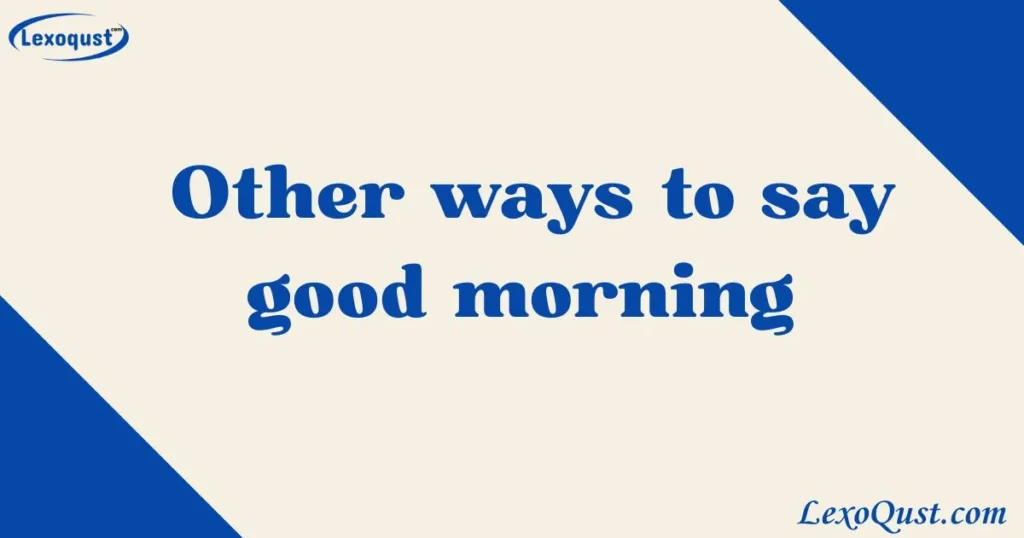Saying “Good morning” is one of the simplest yet most powerful ways to start a conversation and set a positive tone for the day. This common greeting carries warmth, friendliness, and an invitation to connect, making it essential in both personal and professional interactions.
However, relying solely on “Good morning” can sometimes feel repetitive or impersonal, especially when you want to convey genuine enthusiasm or creativity. Exploring other ways to say good morning opens up opportunities to express yourself more vividly and tailor your greeting to different moods, cultures, or settings.
Whether you’re messaging a close friend, addressing a team at work, or writing a blog post, diversifying your morning greetings can enhance your communication and foster stronger relationships.
From casual and cheerful alternatives to more formal or poetic expressions, there’s a wealth of phrases that can brighten someone’s day and reflect your unique voice. Understanding these variations helps you make every morning interaction memorable and meaningful, showing that a simple greeting can be much more than just words.
What Does “Good Morning” Mean?
“Good morning” is a traditional English greeting used to wish someone well at the start of the day. It conveys a sense of friendliness, politeness, and goodwill. The phrase literally means that you are hoping the other person has a pleasant morning. Beyond its literal meaning, it also serves as a simple and respectful way to begin a conversation or interaction, setting a positive tone.
When to Use Good Morning
“Good morning” is typically used from the time a person wakes up or shortly after sunrise until around 12:00 PM (noon). It is suitable in both personal and professional environments, making it a versatile greeting. Whether you are greeting a colleague in the office, a stranger in a coffee shop, or starting an email to a client, “good morning” is an appropriate and polite way to initiate communication.
Is It Professional/Polite to Say Good Morning?
Yes, saying “good morning” is both professional and polite. It is widely accepted in formal settings, such as business meetings, customer service interactions, and workplace conversations, because it demonstrates courtesy and respect.
The phrase helps establish a warm and respectful tone, which is particularly important in first impressions and day-to-day professional interactions. Its simplicity and positivity make it a reliable greeting in nearly any context.
1.Rise and Shine!

Meaning: “Rise and Shine!” is an energetic and optimistic way to greet someone in the morning, encouraging them to start the day with positivity and enthusiasm.
Definition:A motivational phrase used to wake someone up or inspire them to begin their day with brightness and energy.
Tone:Encouraging, upbeat, and lively.
Example. “Rise and shine! Today is your chance to take on new challenges with a fresh mindset.”
Explanation: This phrase is effective because it creates an instant sense of movement and motivation. It not only greets the reader but also invites action, setting an empowering tone early in the message. From the author’s perspective, it helps establish an uplifting connection with the reader.
Purpose and Personalization:The goal of using “Rise and Shine!” is to energize your audience and convey optimism at the start of the day or a new section of your writing. To personalize it, consider your audience’s tone expectations—keep it light for casual or lifestyle content, or modify it slightly (“Let’s rise and shine together”) for a more inclusive or professional feel.
2. Morning Sunshine!
Meaning:A warm, affectionate way to greet someone and brighten their morning.
Definition:This phrase combines a standard greeting with a metaphor of sunlight to convey warmth and friendliness.
Tone:Affectionate and cheerful.
Example:“Morning sunshine! You’ve got this day in the bag.”
Explanation:The phrase is instantly charming and energizing, often used to uplift the mood and show fondness. It adds emotional texture to your writing, making it more inviting.
Purpose and Personalization:Ideal for informal or friendly writing. You can make it more personal by adding a name or nickname—e.g., “Morning sunshine, Alex!” For professional contexts, consider softer alternatives like “Good morning, and here’s to a bright start.”
3. Greetings of the Day!
Meaning:A formal yet pleasant salutation that suits any time of day.
Definition:This is a general expression used to offer well wishes, often in business or cross-cultural settings.
Tone:Polite and neutral.
Example:“Greetings of the day! Let’s begin with positivity.”
Explanation:Its formality can help establish a respectful tone without emotional overload. It’s versatile for audiences you may not know well.
Purpose and Personalization:Use in emails, letters, or global communications. For a softer tone, you could personalize it with a context-based clause, like “Greetings of the day—wishing you success in today’s meeting.”
4. Wishing You a Bright Day!
Meaning:A thoughtful expression of goodwill to encourage optimism.
Definition:This is a kind-hearted statement meant to lift spirits and inspire hopefulness.
Tone:Kind and positive.
Example:“Wishing you a bright day filled with new possibilities.”
Explanation:Its direct focus on the reader’s well-being makes it particularly supportive and thoughtful.
Purpose and Personalization:Best for messages where empathy and encouragement are key. Personalize by referencing something specific—“Wishing you a bright day as you prepare for your presentation!”
5. Top of the Morning!
Meaning:A traditional, cheerful way to say good morning, often associated with Irish English.
Definition:An enthusiastic greeting expressing goodwill early in the day.
Tone:Friendly and old-fashioned.
Example:“Top of the morning! Let’s make it a good one.”
Explanation:Though a bit dated, it adds charm and personality. It works well when a touch of novelty or tradition suits the tone.
Purpose and Personalization:Great for stylized writing or themed content. To modernize it, try something like “Hope your morning’s off to a top start!”
6. Hello Beautiful!

Meaning:A personal, affectionate greeting that makes the reader feel seen and appreciated.
Definition:A warm, flattering salutation often used in close relationships.
Tone:Affectionate and validating.
Example:“Hello beautiful—today’s another chance to shine.”
Explanation:It creates immediate warmth and intimacy, making your tone feel nurturing and supportive.
Purpose and Personalization:Use with a personal or self-help audience. Customize for tone sensitivity—swap in “beautiful soul” or “wonderful you” if “beautiful” feels too direct.
7. Hope Your Day Is as Wonderful as You!
Meaning:A compliment disguised as a well-wish, elevating the reader’s self-worth.
Definition:This phrase connects personal value to the quality of one’s day.
Tone:Uplifting and appreciative.
Example:“Hope your day is as wonderful as you are—because you deserve nothing less.”
Explanation:By tying external experience to internal worth, this line offers both encouragement and validation.
Purpose and Personalization:Excellent for motivational writing. Add specific references for greater impact—“Hope your day is as wonderful as the care you always show others.”
Other ways to say “Welcome Home”
8. Another Day, Another Adventure!
Meaning:Frames daily life as an exciting journey, inspiring a sense of curiosity and purpose.
Definition:A playful reframe of the mundane as an opportunity.
Tone:Adventurous and upbeat.
Example:“Another day, another adventure—where will it take you today?”
Explanation:It transforms routine into excitement, motivating readers to embrace the unknown with confidence.
Purpose and Personalization:Use when energizing or re-engaging the reader. You can add details like “Another day, another adventure—whether at your desk or on the trail.”
9. Happy New Day!
Meaning:Acknowledges the day as a fresh beginning with positive intent.
Definition:A twist on “Happy New Year,” focusing on each day as a chance for joy.
Tone:Optimistic and renewing.
Example:“Happy new day—here’s to fresh energy and open minds.”
Explanation:This greeting re-centers the reader in the present, emphasizing possibility.
Purpose and Personalization:Perfect for reflective or mindful writing. Personalize with goal-oriented phrasing—“Happy new day—ready to tackle those goals?”
10. Morning, Lovely!
Meaning:A tender, casual way to brighten someone’s start to the day.
Definition:An affectionate address paired with a morning greeting.
Tone:Warm and casual.
Example:“Morning, lovely—sending you positive vibes today.”
Explanation:It personalizes the greeting with a flattering touch that feels caring and sincere.
Purpose and Personalization:Great for blogs, journaling, or emails. Adjust the nickname to match your voice or the audience’s preference—e.g., “Morning, starshine” or “Morning, champion!”
11. Time to Rise!

Meaning: Encourages the reader to get up and start their day with purpose.
Definition:A call to action to begin the day, emphasizing readiness and movement.
Tone:Motivational and direct.
Example:“Time to rise—it’s a new day full of potential.”
Explanation:This phrase energizes and prompts engagement, making it a useful opener when you want to stimulate action or momentum.
Purpose and Personalization:Use when urging readers to take initiative. Add a personal twist for emphasis—“Time to rise and take that first step toward your dream.”
12. Here Comes the Sun!
Meaning:Symbolizes hope and renewal with the arrival of light and warmth.
Definition:A poetic way to mark the start of a new day, often suggesting positivity is on the way.
Tone:Hopeful and poetic.
Example:“Here comes the sun—let it warm your spirit and brighten your way.”
Explanation:With literary appeal and emotional resonance, it helps writers craft an inviting and optimistic tone.
Purpose and Personalization:Ideal for reflective or inspirational writing. You can link it to a metaphor—“Here comes the sun, chasing away yesterday’s clouds.”
13. Rise and Conquer!
Meaning:Positions the start of the day as a challenge to be met with determination.
Definition:A call to wake up and approach the day with assertiveness and confidence.
Tone:Empowering and bold.
Example:“Rise and conquer—it’s your time to shine.”
Explanation:This phrase gives the reader a boost of confidence, casting the day as an opportunity to succeed.
Purpose and Personalization:Great for productivity-focused writing. Adapt it to your audience—“Rise and conquer your checklist,” or “Rise and conquer your fears.”
14. Wake Up and Smell the Coffee!
Meaning:Urges awareness and engagement with reality—often with humor.
Definition:An idiomatic prompt to become alert and attentive to what’s happening.
Tone:Witty and slightly provocative.
Example:“Wake up and smell the coffee—opportunities are brewing.”
Explanation:This energizing phrase breaks formality and invites immediate focus with a relatable metaphor.
Purpose and Personalization:Use in conversational or persuasive writing. Swap in other sensory images for variation—“Wake up and smell the roses” (gentler), or “Wake up and see what’s possible.”
15. Good Day Ahead!

Meaning:Focuses attention forward, implying positive expectations.
Definition:A brief message of hope or prediction for a successful day.
Tone:Optimistic and steady.
Example:“Good day ahead—let’s walk into it with purpose.”
Explanation:It sets an encouraging mood and can help frame upcoming content in a positive light.
Purpose and Personalization:Best used when transitioning into goal-setting or forward-looking sections. Add specifics—“A good day ahead for creative breakthroughs!”
16. Morning Vibes Only!
Meaning:Creates a boundary around the early-day mood—positive, fresh, and present.
Definition:A casual phrase promoting a focused, uplifting morning mindset.
Tone:Trendy and relaxed.
Example:“Morning vibes only—leave the stress for later.”
Explanation:It’s catchy, contemporary, and signals that this space is reserved for good energy.
Purpose and Personalization:Fits social media, lifestyle writing, or casual blogs. Add emojis or colloquial tags if appropriate—“#morning vibes only 💫.”
17. Let’s Make Today Count!
Meaning:An appeal to use the day meaningfully, with intention and value.
Definition:Motivates readers to act with purpose and not waste time.
Tone:Encouraging and purposeful.
Example:“Let’s make today count—start with one meaningful task.”
Explanation:The collective “let’s” draws readers in and makes the call feel communal and supportive.
Purpose and Personalization:Effective in goal-oriented writing. Customize by adding goals—“Let’s make today count by finishing what we started.”
18. Morning Glow!
Meaning:Celebrates the gentle beauty and calm of a new day.
Definition:A poetic phrase referring to the soft, promising light of morning.
Tone:Soothing and elegant.
Example:“Feel the morning glow—it’s your cue to begin anew.”
Explanation:Conveys serenity and presence, grounding the reader in the moment with sensory appeal.
Purpose and Personalization:Use in mindful or wellness writing. Enhance with visuals—“The morning glow settles over your journal and cup of tea.”
19. Cheers to a New Day!
Meaning:A celebratory toast to the arrival of a new beginning.
Definition:A lively way to acknowledge the potential in today.
Tone:Festive and light-hearted.
Example:“Cheers to a new day—may it bring clarity and courage.”
Explanation:Creates a sense of shared excitement, like a fresh toast to possibilities.
Purpose and Personalization:Great for engaging readers early. You can shift tone with modifiers—“Cheers to a calm, productive day.”
20. A Fresh Start Awaits!

Meaning:Reframes the day as a clean slate full of possibility.
Definition:A motivational reminder that every day offers new opportunities.
Tone:Hopeful and inspiring.
Example:“A fresh start awaits—no matter what yesterday looked like.”
Explanation:Gives readers permission to let go of past frustrations and refocus on what’s ahead.
Purpose and Personalization:Perfect for habit-forming or recovery content. Personalize it to your reader’s journey—“A fresh start awaits your creativity.”
21. Make Today Amazing!
Meaning:Encourages proactive joy and intention.
Definition:A directive to shape the day positively through mindset and action.
Tone:Encouraging and upbeat.
Example:“Make today amazing—start with what lights you up.”
Explanation:It reinforces the reader’s power over their experience, motivating agency.
Purpose and Personalization:Strong for morning affirmations or challenges. Tailor the tone—“Make today amazing by doing one bold thing.”
22. Have a Beautiful Day!

Meaning:A simple, classic expression of well-wishing.
Definition:A warm, standard closing or greeting that offers goodwill.
Tone:Friendly and gentle.
Example:“Take care, and have a beautiful day.”
Explanation:Timeless and widely appreciated, this phrase fits nearly any positive message.
Purpose and Personalization:Use as a closer or transition. Personalize with an emotional touch—“Have a beautiful day, filled with laughter and peace.”
23. Good Morning, Gorgeous!
Meaning:A direct complement paired with a friendly morning greeting.
Definition:An affectionate, confidence-boosting start to the day.
Tone:Playful and flattering.
Example:“Good morning, gorgeous—remember, you’re unstoppable.”
Explanation:Builds confidence and energy early in the message, especially useful in personal or affirmational content.
Purpose and Personalization:Suited for informal or loving tones. Adapt the compliment to suit tone—“Good morning, superstar!” or “Good morning, bright mind!”
24. Today Is Yours!
Meaning:Empowers the reader with ownership and possibility.
Definition: A reminder that the day belongs to them and they have control over it.
Tone: Empowering and supportive.
Example: “Today is yours—make it what you need it to be.”
Explanation: Encourages autonomy and builds motivation through choice.
Purpose and Personalization: Excellent for self-improvement or goal-setting. Add context—“Today is yours, even if you start slow.”
Other ways to say Happy Monday
25. Enjoy Your Day!
Meaning: A well-meaning wish for pleasant experiences ahead.
Definition: A casual expression of goodwill for the day’s events.
Tone: Friendly and relaxed.
Example: “Take a breath, and enjoy your day.”
Explanation: This common phrase works universally and gently guides the reader into a positive headspace.
Purpose and Personalization: Ideal as a closing line. Enhance it with purpose—“Enjoy your day—especially that coffee break you deserve.”
26. Here’s to a Great Day!

Meaning: A toast-like wish expressing optimism for the day’s outcome.
Definition: A celebratory or hopeful expression of support.
Tone: Affirming and cheerful.
Example: “Here’s to a great day—one that brings progress and peace.”
Explanation: This phrase invites shared hope, perfect for setting collective intention.
Purpose and Personalization: Use at the start of newsletters or team messages. Add detail—“Here’s to a great day of creativity and kindness.”
27. Morning, Friend!
Meaning: Fosters connection and trust with a friendly, informal tone.
Definition: A personal and caring way to start a message.
Tone: Warm and welcoming.
Example: “Morning, friend—just a reminder that you’re not alone.”
Explanation: Directly addressing the reader as a “friend” builds intimacy and comfort.
Purpose and Personalization: Great for community-based writing. Adjust tone with related terms—“Morning, kind soul,” or “Morning, team.”
28. Wishing You Joy Today!
Meaning: A heartfelt expression of hope for happiness.
Definition: A simple yet powerful intention for the reader’s emotional state.
Tone: Sincere and uplifting.
Example: “Wishing you joy today—in big moments and small.”
Explanation: Emphasizes emotional well-being, creating a compassionate tone.
Purpose and Personalization: Perfect for support-focused or wellness writing. Personalize with situation—“Wishing you joy today as you begin your new role.”
29. May Today Be Wonderful!
Meaning: A hopeful, respectful way to wish someone a positive day.
Definition: A formal but kind-hearted expression of good wishes.
Tone: Respectful and gracious.
Example: “May today be wonderful, just as you deserve.”
Explanation: The gentle tone allows for formality while still being personal.
Purpose and Personalization: Use in formal writing or messages to new audiences. Add specific support—“May today be wonderful as you step into this new chapter.”
30. Shine Bright Today!

Meaning: Encourages the reader to be confident and bring their best self forward.
Definition: A motivational phrase suggesting boldness and positivity.
Tone: Empowering and radiant.
Example: “Shine bright today—your presence makes a difference.”
Explanation: Uses metaphor to inspire confidence and action, perfect for affirming messages.
Purpose and Personalization: Effective in self-growth or motivational writing. Adapt for tone—“Shine bright today, no matter who’s watching.”
31. Embrace the Morning Light!
Meaning: Invites the reader to accept the new day with openness and gratitude.
Definition: A poetic expression encouraging presence and appreciation of the morning.
Tone: Gentle and inspirational.
Example: “Embrace the morning light—it’s a reminder that each day begins with beauty.”
Explanation: This phrase emphasizes mindfulness and new beginnings, ideal for guiding the reader into a centered, peaceful mindset.
Purpose and Personalization: Perfect for wellness or meditative writing. Personalize by connecting to the reader’s experience—“Embrace the morning light, even if the night felt long.”
32. A New Dawn, A New You!
Meaning: Frames the morning as a chance for personal reinvention or growth.
Definition: An empowering phrase suggesting the day is a reset button for one’s mindset or actions.
Tone: Motivational and hopeful.
Example: “A new dawn, a new you—what will you create today?”
Explanation: This phrase combines imagery with empowerment, nudging the reader toward self-evolution.
Purpose and Personalization: Great for transformation-themed writing. Adjust to fit the context—“A new dawn, a new project,” or “…a new mindset.”
33. Your Morning, Your Momentum!
Meaning: Highlights that how you start your morning sets the tone for the rest of your day.
Definition: Encourages the reader to take charge of their morning to build productive energy.
Tone: Focused and energizing.
Example: “Your morning, your momentum—fuel it with what matters most.”
Explanation: Reinforces autonomy and control over one’s pace and direction.
Purpose and Personalization: Ideal for productivity or goal-setting content. Add detail for niche relevance—“Your morning, your momentum—begin with clarity and stretch.”
34. Step Into the Day with Purpose!
Meaning: Encourages intentional action and focus from the moment the day begins.
Definition: A call to embrace the day with mindfulness and direction.
Tone: Encouraging and deliberate.
Example: “Step into the day with purpose—each moment is yours to shape.”
Explanation: Focuses on clarity and choice, aligning well with readers seeking structure or self-leadership.
Purpose and Personalization: Excellent for time management or mindset themes. Customize based on role or habit—“Step into the day with purpose, as a leader, a learner, or a dreamer.”
35. Bright Mornings Bring Bold Moves!

Meaning: Connects the energy of morning with confidence and action.
Definition: A spirited reminder that mornings are prime time for making courageous decisions.
Tone: Bold and empowering.
Example: “Bright mornings bring bold moves—what leap will you take today?”
Explanation: Pairs optimism with action, encouraging readers to harness morning energy for decisive change.
Purpose and Personalization: Best for writing on ambition, entrepreneurship, or motivation. Personalize with context—“Bright mornings bring bold moves—maybe it’s time to write that first chapter.”
36. Unique Ways to Say Good Morning
Meaning: Expressing morning greetings in a distinct and memorable way that stands out.
Definition: Creative alternatives to the standard “good morning” that reflect originality.
Tone: Fresh, engaging, and thoughtful.
Example: “Wishing you a sunrise as bright as your smile.”
Explanation: Unique greetings capture attention and create a lasting impression, helping your message feel more personal and meaningful.
Purpose and Personalization: The goal is to make your morning greeting special and different. Personalize by tying it to the recipient’s interests, mood, or context (e.g., “Hope your coffee kicks in faster than Monday blues”).
37. Romantic Ways to Say Good Morning

Meaning: Conveying affection and warmth in a morning greeting for a loved one.
Definition: Sweet phrases that express love and closeness at the start of the day.
Tone: Tender, affectionate, and loving.
Example: “Good morning, my sunshine. You make every day brighter.”
Explanation: Romantic greetings strengthen emotional bonds by showing thoughtfulness and care in everyday moments.
Purpose and Personalization: The aim is to nurture intimacy and emotional connection. Adjust by including pet names, inside jokes, or shared dreams to make it feel personal and heartfelt.
38. Funny Ways to Say Good Morning
Meaning: Lightening the start of the day with humor and playfulness.
Definition: Amusing alternatives that bring a smile instead of a plain greeting.
Tone: Playful, cheerful, and witty.
Example: “Morning! May your coffee be strong and your Monday be short.”
Explanation: Humor sets a positive mood and can instantly brighten someone’s morning, making the message more enjoyable.
Purpose and Personalization: The purpose is to spread joy and laughter. Tailor the humor to the recipient’s style—use puns, inside jokes, or light sarcasm depending on what suits their personality.
39. Cute Ways to Say Good Morning

Meaning: Delivering a greeting that feels sweet, soft, and endearing.
Definition: Adorable expressions that show care in a lighthearted way.
Tone: Gentle, cheerful, and affectionate.
Example: “Rise and shine, sleepy panda!”
Explanation: Cute greetings add warmth and positivity, making the recipient feel cared for and appreciated.
Purpose and Personalization: The goal is to create a sense of sweetness and joy. Adjust by using nicknames, emojis, or playful imagery that resonates with the person you’re addressing.
40. Formal Ways to Say Good Morning
Meaning: Offering a respectful and professional morning greeting.
Definition: Polished alternatives suited for workplaces, meetings, or formal contexts.
Tone: Respectful, professional, and polite.
Example: “Good morning, I hope your day is off to a productive start.”
Explanation: Formal greetings maintain professionalism and set the right tone in business or official communication.
Purpose and Personalization: The aim is to show respect while building rapport. Personalize by adding context (e.g., “Good morning, thank you for joining today’s meeting”) to balance professionalism with courtesy.
Conclusion:
Choosing the right morning greeting sets the tone for warmth, clarity, and connection. Thoughtful word choice can transform a simple phrase into a powerful moment of encouragement. Whether you’re crafting a blog, a letter, or a professional message, using creative expressions for ‘good morning’ adds authenticity and emotional impact.
I encourage you to weave these greetings into your writing, embracing your personal voice to uplift your readers. This guide is more than a resource it’s a spark for deeper, more meaningful communication. Now, go ahead and start your message with heart your words matter.

Hi! I’m Amelia Ashford, the admin of Lexoqust.com. Here, we dive deep into the world of synonyms to help you express yourself better.From everyday words to advanced vocabulary, Lexoqust makes your writing richer and more refined.



